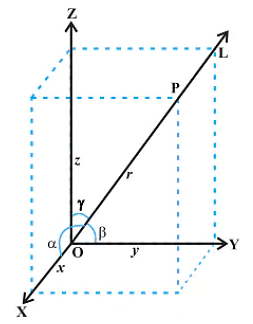The combined equation of the two lines $a x+b y+c=0$ and $a^{\prime} x+b^{\prime} y+c^{\prime}=0$ can be written as $(a x+b y+c)\left(a^{\prime} x+b^{\prime} y+c^{\prime}\right)=0$
The equation of the angle bisectors of the lines represented by the equation $2 x^2+x y-3 y^2=0$ is
The equation of the angle bisectors of the lines represented by the equation $2 x^2+x y-3 y^2=0$ is
- $3 x^2+5 x y+2 y^2=0$
- $x^2-y^2-10 x y=0$
- $3 x^2+x y-2 y^2=0$
- $x^2-y^2+10 x y=0$
The Correct Option is B
Approach Solution - 1
Here
Equation will become
Approach Solution -2
Step 1: Equation of the pair of angle bisectors for the homogeneous equation \[ ax^2 + 2hxy + by^2 = 0 \] is given by: \[ \frac{x^2 - y^2}{a - b} = \frac{xy}{h} \]
Step 2: Here, \[ a = 2, \quad h = \frac{1}{2}, \quad b = -3 \] Thus, equation becomes: \[ \frac{x^2 - y^2}{2 - (-3)} = \frac{xy}{\frac{1}{2}} \] \[ x^2 - y^2 - 10xy = 0 \]
Top Questions on measurement of angles
- Find the smallest angle of the triangle whose sides are \( 6 + \sqrt{12}, \sqrt{48}, \sqrt{24} \).
- MHT CET - 2025
- Mathematics
- measurement of angles
- Evaluate the expression: \[ \frac{\sin \frac{\pi}{7} + \sin \frac{3\pi}{7}}{1 + \cos \frac{\pi}{7} + \cos \frac{2\pi}{7}} \]
- KEAM - 2025
- Mathematics
- measurement of angles
- Find the values of: \[ \cos 75^\circ, \cos 15^\circ, \cos 45^\circ \]
- KEAM - 2025
- Mathematics
- measurement of angles
- The mean deviation about the mean for the data \( 4, 7, 8, 9, 10, 12, 13, 17 \) is:
- KCET - 2025
- Mathematics
- measurement of angles
- If \( \theta \) is the acute angle between the curves \( y^2 = x \) and \( x^2 + y^2 = 2 \), then \( \tan \theta \) is:
- TS EAMCET - 2024
- Mathematics
- measurement of angles
Questions Asked in JEE Main exam
Nature of compounds TeO₂ and TeH₂ is___________ and ______________respectively.
- JEE Main - 2025
- Inorganic chemistry
- Let \( A = [a_{ij}] \) be a matrix of order 3 \(\times\) 3, with \(a_{ij} = (\sqrt{2})^{i+j}\). If the sum of all the elements in the third row of \( A^2 \) is \( \alpha + \beta\sqrt{2} \), where \(\alpha, \beta \in \mathbb{Z}\), then \(\alpha + \beta\) is equal to:
- JEE Main - 2025
- Matrices and Determinants
Consider the following sequence of reactions :

Molar mass of the product formed (A) is ______ g mol\(^{-1}\).- JEE Main - 2025
- Organic Chemistry
The magnitude of heat exchanged by a system for the given cyclic process ABC (as shown in the figure) is (in SI units):

- JEE Main - 2025
- Electric charges and fields
- The value of \( (\sin 70^\circ)(\cot 10^\circ \cot 70^\circ - 1) \) is:
- JEE Main - 2025
- Trigonometric Identities
Concepts Used:
Three Dimensional Geometry
Mathematically, Geometry is one of the most important topics. The concepts of Geometry are derived w.r.t. the planes. So, Geometry is divided into three major categories based on its dimensions which are one-dimensional geometry, two-dimensional geometry, and three-dimensional geometry.
Direction Cosines and Direction Ratios of Line:
Consider a line L that is passing through the three-dimensional plane. Now, x,y and z are the axes of the plane and α,β, and γ are the three angles the line makes with these axes. These are commonly known as the direction angles of the plane. So, appropriately, we can say that cosα, cosβ, and cosγ are the direction cosines of the given line L.
